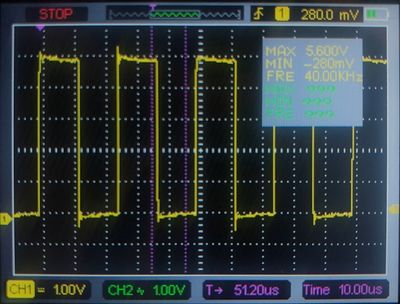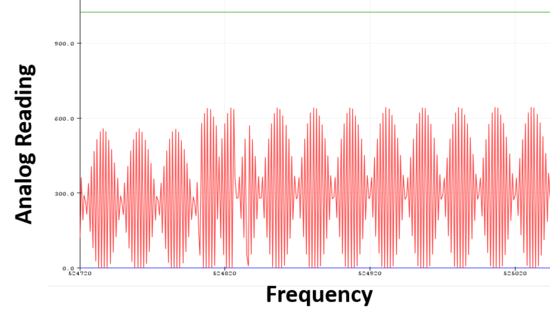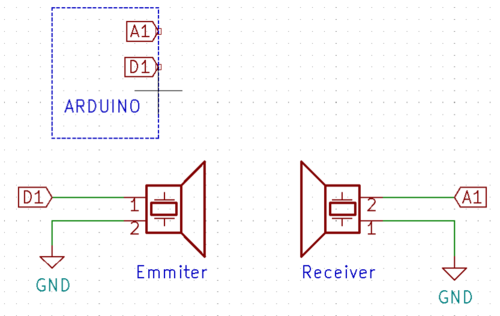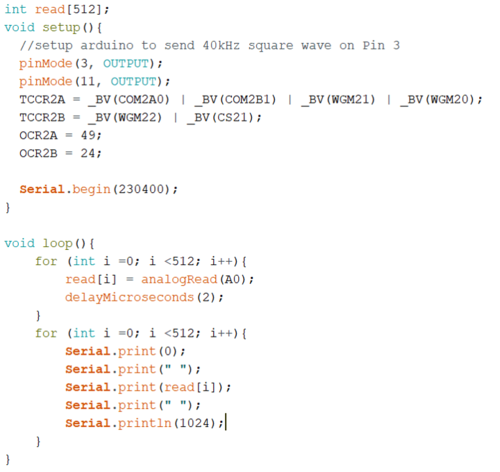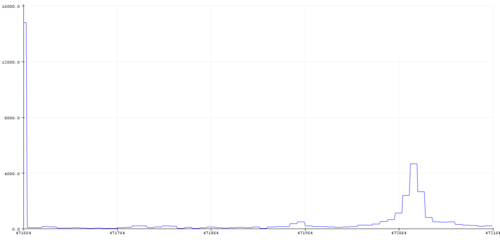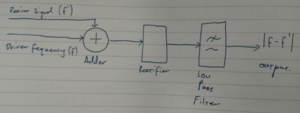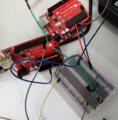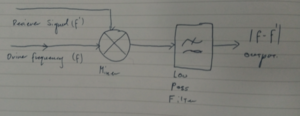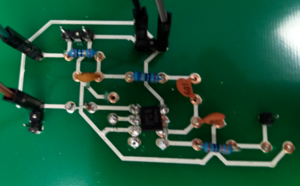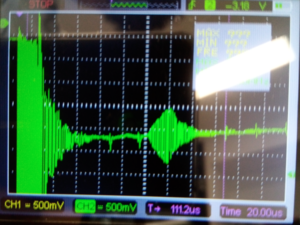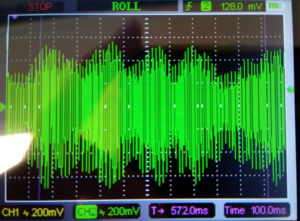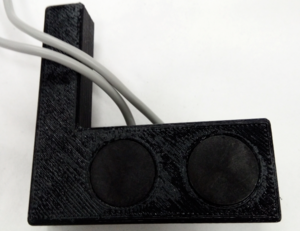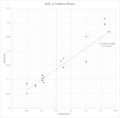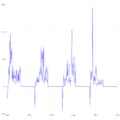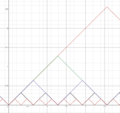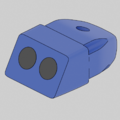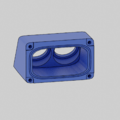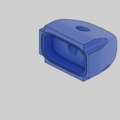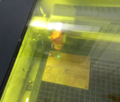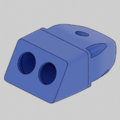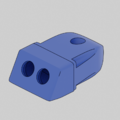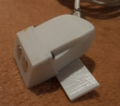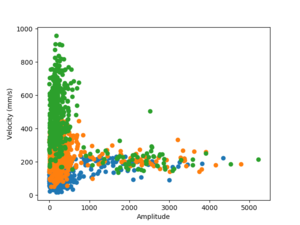In Water Vel Sensor
This section documented our journey to develop a low-cost water velocity sensor based on doppler effect!
Contents
- 1 20th November 2019
- 2 21th November 2019
- 3 25th November 2019
- 4 26th November 2019
- 5 27th November 2019
- 6 28th November 2019
- 7 29th November 2019
- 8 3rd December 2019
- 9 4th December 2019
- 10 5th December 2019
- 11 9th December 2019
- 12 12th December 2019
- 13 16th December 2019
- 14 19th December 2019
- 15 22nd January 2020
- 16 3rd February 2020
- 17 4th February 2020
- 18 7th February 2020
- 19 10th February 2020
- 20 11th February 2020
- 21 12th February 2020
- 22 13th February 2020
- 23 14th February 2020
- 24 28th February 2020
- 25 6th March 2020
- 26 9th March 2020
- 27 16th March 2020
- 28 24th March 2020
- 29 5th April 2020
- 30 9th April 2020
- 31 11th April 2020
- 32 12th April 2020
- 33 13th April 2020
- 34 14th April 2020
- 35 17th April 2020
- 36 22nd April 2020
- 37 24th April 2020
- 38 27th April 2020
- 39 9th May 2020
20th November 2019
So the first task we are going to try is to use Arduino to generate 40 kHz square wave and emit that signal by using a ultrasonic transducer.
By facing another same transducer to the one emitting the ultrasonic signal, we can successfully detect that signal.
Figures below show the generated square wave from the emitting transducer (measured by an oscilloscope), and the detected wave signal from the receiver transducer (by using AnalogRead).
The figure here shows how we wire up the transducers with Arduino to conduct this quick test. The code we used is also attached here to show you how to use Arduino to generate a certain frequency.
21th November 2019
What are we going to try today is to place the two transducers next to each other and facing the same direction.
One emit the signal to a metal wall, and the receiver to detect the signal bounce back.
Multiple op-amps will be used to strength the signal to make it strong enough for Arduino to detect.
25th November 2019
For the arduino to effectively read the low amplitude high frequency signals it is going to need some assistance via external circuitry.
We tested an non-inverting op-amp design based on the LM324. This proved to have challenges reproducing the high frequency signals and after some diagnosis, we determined that the slew rate of the LM324 was too low.
The image above shows the limited slew rate experienced from the LM324N. In this domain the waveform appear as linear as the OpAmp attempts to match the proper signal. It demonstrated a slew rate of about 0.5 V / μS. To overcome this we will need to replace the LM324N with a better OpAmp.
By default the Arduino ADC sample frequency is rather slow at 45 kHz. For our application we will need much faster sampling rates. Fortunately, the clock divider which the ADC runs on (default 32x) is user settable. In testing various values for this, a sample rate of 615 kHz was able to be achieved. <1>
This was accomplished via the following code:
26th November 2019
We tested out some LM883N and NE5532AP OpAmps to see if they performed better than the LM324 (they have a slew rating of ~5 V / μS so they should). Both worked much better than the LM324 being able to reproduce the waveform however, we found that the NE5532AP was better at higher gains.
It was found that the circuit below performed well at amplifying the AC signal of the receiver resonator.
The gain can be adjusted through resistors Ra and Rb via the formula: Gain = 1 + Ra/Rb
Issues were faced where very high noise was present on the output of the op-amp. Some investigation revealed that this was due to the same Arduino driving the 40 kHz squarewave as powering the op-amp. This limited the ability to receive low amplitude signals and made it difficult to detect the reflected ultrasonic waves. A temporary solution to this was to use separate Arduinos for the transmitted and receiver.
A noise profile was obtained by having the ultrasonic receiver covered and placed such that no ultrasonic frequencies would be measured by it. The op-amp output was then measured. Below are the measurements for the two-Arduino setup vs the one-Arduino setup.
The noise is improved in the two-Arduino setup however there is still a significant ammount, it may be necessary to make a PCB with better noise isolation for test which require higher sensitivity.
Arduino Sample Frequency
<1> From doing more test it appears that not all Arduinos are able to sample at the 615 kHz rate, a more reliable max appears to be 215 kHz.
Testing the values of the clock divider registers ADPS2, ADPS1, ADPS0, the following table was made indicating about the various sample frequency on a 16 MHz 5 V ATmega382P (Arduino Uno).
| ADPS2 | ADPS1 | ADPS0 | Sample Frequency (kHz) | Working |
|---|---|---|---|---|
| 0 | 0 | 0 | 325 | No |
| 0 | 0 | 1 | 325 | No |
| 0 | 1 | 0 | 215 | Yes |
| 0 | 1 | 1 | 125 | Yes |
| 1 | 0 | 0 | 66 | Yes |
| 1 | 0 | 1 | 35.6 | Yes |
| 1 | 1 | 0 | 17.6 | Yes |
| 1 | 1 | 1 | 8.9 | Yes |
Arduino Frequency Measurement
To measure frequency an DFT was performed on a 128 size sample at 215 kHz of the amplified ultrasonic receiver signal.The sample frequency was chosen as it was the highest stable, and the sample size as this was the limit of the ATmega382p's memory.
The y-axis height represents strength of that component frequency, and the x-axis the frequency bins, where eight bins corresponds to 1.7 kHz
Concerningly the peak height is at about 90 kHz, and the predominant frequency when measured with an oscilloscope is 40 kHz.
27th November 2019
Some thought was conducted into the feasibility of direct frequency measurement using the ATmega328p and extracting the Doppler shift digitally.
The velocity is given by the equation: v = c/2 (fd/f) cos(θ), where c is the speed of sound, fd is the Doppler shift, f is the emitted frequency, and θ is the angle between the flow and sensor.
Let us assume that the sensor is parallel to the flow (θ = 0). By Nyquist-Shannon sampling theory, to detect a frequency at f we need the ATmega328p to sample at 2f. Applying a DFT to this sample gives a frequency resolution Δf of 2f/N, where N is the number of samples. Therefore, making the substitutions fd = 2f/N, θ = 0, we get: Δv = c/2 (2f/(f*N)) = c/N
For water (c = 1500 m/s) and a velocity resolution of Δv = 0.1 m/s this implies that 15 000 samples would need to be taken. This would require an amount of memory well beyond the 2 kB of the Arduino (which can realistically only store 128 samples).
This implies that direct measurement of the Doppler shift is not feasible and that some signal pre-processing is necessary. The idea is to extract the Doppler shift so that we can have a easier time sampling the lower frequency Doppler shift signal.
There are two approaches which we are going to trial, amplitude demodulation, and a heterodyne converter.
Amplitude Demodulation
The premise of the AM demodulator is that the sum of the two signals produces a beating frequency (f' - f) which is conveniently also the Doppler shift fd. The rectifier eliminates the negative peaks of the resultant sum, and the low pass filter blocks the high frequency carrier wave of the signal, leaving only the low frequency Doppler shift.
The draw back of this method is that the signal is very weak, and it is difficult to scale to higher frequencies.
A pathfinder version of this circuit was constructed as indicated in the diagram. The inputs were provided by two Arduino Unos with one generating a 40 kHz 5Vpp Square wave, and the other a 43.4 kHz square wave. The output as measured by an oscilloscope was good, displaying an about 3.4 kHz wave which was the difference in the two frequencies. The output was however, a bit noisy, and low in amplitude (~500 mV). Building this on a proper PCB should help eliminate some of the noise and allow the output to be amplified.
The 43.3 kHz Arduino was then disconnected from the circuit and the ultrasonic transducers were wired into the circuit, (with some appropriate changes to the resistor values). The transducers were then placed so that they were facing each other and then the receiver was moved back and forward at a steady rate. The output of the demodulator was able to detect the Doppler shift and thus this motion, however much noise was present and the signal was weak.
Heterodyne Pre-Processing
The Heterodyne is more standard for high frequency Doppler shift applications, the mixer multiplies the two signals. For two sine waves with frequencies fa and fb, their product will be the sum of cosines with frequencies |fa-fb| and |fa + fb|. For fa = f', and fb = f, the lower frequency signal is the Doppler frequency, which can then be isolated from the higher frequency using a low pass filter. This method provides the advantage of it being proven to work at a wide range of frequencies, in excess of 500 MHz.
28th November 2019
Following on from yesterday, I tested to see if the Arduino could analyse the output of the AM demodulator circuit. The output of the circuit was connected analog pin A1, and the below code was run.
The code, generates a 40 kHz 5 Vpp square wave on pin 3, then samples at 100 Hz on pin A1 for 128 samples. This data is then passed on the arduinoFFT library when does a DFT on the data to convert it into the frequency domain. The frequency domain data is then plotted to serial.
Running this code while moving the ultrasonic sensor at about 4 cm/s. The FFT in the gallery was the output.
The peak is seen at about bin 10. The bin frequency is given by fb = fs/N, where fs is the sampling rate (100 Hz in this case) and N the number of samples (128). This gives a bin frequency in our case of 0.78 Hz. As we are interested in bin 10, our Doppler frequency is 7.8 Hz.
Using the formula: v = c/2 (fd/f) => v = 340/2 (7.8/40 000) => v = 3.3 cm/s
Which is within our margin of error for the velocity, and indicates that the principle behind the sensor is as observed.
AM Demodulator PCB
PCB drawn up to take the AM demodulator off the breadboard and hopefully reduce some noise. Off to the Voltera!
Note: C1 was changed to from 1 μF to 100 nF as it had better performance.
The circuit works well, much the much better noise floor creates greatly improves the signal to noise ratio. The signal is still a bit weak however some more amplification may help this out. An oscilloscope is able to detect the Doppler shift when the transducers are facing each other and one is moved from about 1 meters distance, and from about half a meter when the signal is bounced off a wall. It is hoped that optimization of the values of the components can improve on this.
Additionally, it still needs to be tested if the Arduino can detect the signal from this.
When the traducers are facing each other, the Arduino is able to read the voltage and perform the analysis on it. Below is an FFT plot from the Arduino in this arrangement.
Wrote some code to use the frequency data to determine the speed. Initial tests indicate its working well, although a proper trial with calibrated speed references will be necessary to be sure if its working properly.
29th November 2019
Some tuning was done to the AM demodulator circuit to improve performance. One issue found when probing with the oscilloscope is that the output of the opamp was being clipped as the amplification was too large, and so the resistor R6 was changed to 5 kΩ to prevent this.
3rd December 2019
Some testing was done into if it would be possible for an Arduino to produce a 1 MHz frequency, which will be needed if we want to switch to a 1 MHz transducer. It was able to generate the waveform, however, significant ringing did occur on the rising and falling edge. This may be able to be alleviated with a capacitor if it becomes an issue.
Heterodyne Circuit
In order to switch to using higher frequencies the heterodyne circuit topology is going to be needed. A circuit based on the SA612AD is going to be build according to this schematic.
Building this circuit, it seems to perform effectively, and with a output signal much cleaner and stronger than the AM demodulator. The waveform in the gallery was taken with the two 40 KHz ultrasonic sensors pointing towards a wall about 30-50 cm away. The amplitude of the signal being about 80 mV should be able to be detected by the Arduino, however if not the output signal is SNR is low enough that amplification could be done. Furthermore, it seems as though the low pass filter has a much easier time of isolating the low frequency component of interest when compared to the AM modulator, another benefit of this design.
For two 40 KHz ultrasonic sensors facing each other at about a half a meters distance, the Arduino was used to record the output of the Heterodyne Circuit. The FFT of the signal is shown below. It is seen that the signal produces a much more distinct peak at the Doppler frequency, which will help the extraction of the velocity from this output.
In investigating the SA612AD, the two RF inputs IN_A and IN_B can be used to form a ballanced line. Connecting either side of the Ultrasonic transducer to a these pins through a 100 nF series capacitor, reduces the noise which is introduced into the amplifier, and so improves the sensitivity of the circuit.
1.7 MHz Tranducers
Having success in measuring the Doppler shift at the lower frequencies, it is time to test out the higher frequency ultrasonic transducers.
The specific piezoelectric disk which we going to be testing is: https://au.mouser.com/ProductDetail/PUI-Audio/UB161M7?qs=pFWzdYhrkoc8QGl1JZ231g%3D%3D
It has a rated resonant frequency of 1.7 MHz, however the Arduino is only able to produce frequencies an integer division of its clock frequency (16 MHz). It was found that out of the frequencies which the Arduino could generate (16 MHz / 9 = 1.78 MHz) produced the largest resonance in the ultrasonic transducers.
These disk do not come with any wires soldered to them and so this needed to be done manually. Something which was quite difficult as the solder contacts ideally should be quite small.
In modifying the above Heterodyne circuit for use with the 1.7 MHz tranducers, I found that the grounding on the breadboard is not good enough for a low noise output. I might have to make a PCB for it, or add better grounding.
The noise was not able to be solved easily, and so a PCB is going to be made.
4th December 2019
Little success was had with the PCB, the higher frequencies of the 1.7 MHz tranducers results in many more complications in the circuit design. Additionally, with the multiple problems present it is difficult to isolate and diagnose how each part of the circuit affects the overall performance.
In testing the circuit works well at 40 KHz, better heterodyne circuit built on the breadboard. As the IC is rated for operations up to hundreds of MHz, this narrows down the source of the issue to be either, the ultrasonic tranducers, the signal integrity, or the values of some of the components being unsuitable for MHz work.
Transducer Resonant Frequency
I measured the resonant frequency of the two 1.7 MHz traducers using the oscilloscope. The values were quite a bit off from 1.7 MHz with one being 1.64 MHz and the other 1.63 MHz. It is likely that this shift is because of the wires which needed to be soldered on to the traducers. This shift could also be one of the reasons that the circuit is working.
In re-reading the datasheet and conducting some testing on the tranducers, they are a type of transducer known as a bender. This type is more suited towards high voltage application 10s of Volts, and is not suited to detecting small pressures as are those found in ultrasonic air waves. These tranducers do not have the characteristics necessary for our application, and so hopefully the ones in the post are better.
1 MHz Transducer
I had a bit of a test with the 1 MHz ultrasonic tranducer: https://www.digikey.com/product-detail/en/unictron-technologies-corporation/H2KLPY11000600/2047-H2KLPY11000600-ND/9921487, to see if it was able to detect a reflected signal.
The setup was to send 20 1 MHz pulses to the transducer and then use an oscilloscope to monitor if any reflected signal was present.
In air this was not able to be done. Varying the distance didn't seem to help either no reflected signal ever being detected in the osciloscope.
In water however, the results were quite successful. The waveform attached is of the transducer facing down into a cylinder of water about 15 cm high, the surface of the transducer was touching the water. As can be seen the reflected waveform produces a distinct peak, some time after the driving pulse is stopped.
The reason that the trial in water worked, whereas the one in air didn't is probably to do with impedance matching. That is at higher frequencies, much less of the vibrational energy gets transferred from the tranducer to the low density and slow speed of sound air than compared to the more dense and higher speed of sound water. This is something which we will need to pay close attention to as we wish to maximize the amount of energy that gets transferred into the medium, so we can have an easier time detecting the reflections.
5th December 2019
We found some new 1 MHz ultrasonic transducers, and they seems to be more suited towards transducer application: (https://www.steminc.com/PZT/en/piezo-ceramic-disc-10x2mm-r-215-khz-wire-leads-smd10t2r111wl).
I tested the resonant frequency and found it to be the quoted 1 MHz.
Good news! The transducers are transduceing, that is to say, using the oscilloscope you can detect the oscillation of the driven transducer with the receiver transducer. It is important to note here that these tests were done in water as in air the coupling is too weak.
The tranducers also seem to have a resonant frequency at just undre 250 kHz, about 243 kHz. This one actually seems to be stronger, with more signal being transduced at this frequency.
The reflected pulse off the bottom of a cylinder of water was not able to be measured by this transducer, as with the previous 1 MHz transducer.
In doing some preliminary testing, it is looking like all of the MHz tests are going to need to be conducted in water. Additionally, it appears as though the container shape matter as the ultrasonic waves tend to reflect off the walls and create resonances in the cylinder, this interferes with the signal.
With some adjustment to the capacitor C? from 68 pF to 170 pF, I was able to get a signal out of the Heterodyne circuit when both of the transducers were facing each other. The signal was weak and still had a significant 250 kHz component, but it was able to be measured with an oscilloscope.
9th December 2019
Some new ultrasonic transducers arrived. They are already enclosed and wired up so they look more promising than the other ones.
I used the function gen and oscilloscope to get a precise reading on the resonant frequency in air and it is about 1.018 MHz. This value was obtained by finding the local minimum in amplitude across the traducer, with a series 330 Ω resistor, when sweeping through the frequencies using a function gen.
In water the resonant frequency was 0.999 MHz, which is within the measurement error for the manufacturers quoted 1 MHz
I conducted another test in which I applied a 1 MHz frequency to one transducer in water and measured the voltage across another transducer with an oscilloscope. A few good things to note from this was that more voltage across the input transducer produces a stronger signal on the output transducer. The relationship is not exactly linear but it is fairly proportional, with diminishing returns occurring at larger voltages. Also, the arrangement of the transducers is very important, they need to be facing each other or have a good path through a reflection off a wall. Otherwise the signal is almost undetectable.
I hooked up the transducers to the Heterodyne circuit with the Signal Gen providing the 1 MHz input wave. Using an oscilloscope I am able to detect the motion of the transducers. The signal is very weak and still superimposed with the 1 MHz input wave so I am unable to upload a meaningful image of it yet.
Passing the signal through a low pass filter (f = 4.5 kHz), the doppler shift becomes much more visible on the oscilloscope. In this setup the transducers were placed such that the wave reflected off the bottom of a cylinder of water. The input wave did have to be increase to 9 Vpp, however this can be reduced later once the circuit is tuned correctly. Attached are two images one of the output when the receiver is still and one when it is being moved very slowly, (> 1 cm/s). The Doppler frequency is clearly visible when comparing these two, I suspect that the low frequency wave in the no motion waveform is an artifact of the oscilloscope.
At this point, the circuit-transducer combo is quite well tested, and it is time to look at getting a proper PCB manufactured and encasing the transducers.
12th December 2019
A housing was printed for the ultrasonic sensors to keep them well aligned and as a prototype for the final packaging of the sensor.
16th December 2019
A schematic for the PCB was drawn up. It features an onboard 1 MHz clock generator to provide the stable 1 MHz signal needed for the Tranducers, and it outputs the low frequency Doppler shift.
A rendering of the PCB is also shown in the gallery.
19th December 2019
The heterodyne circuit and the 1 MHz tranducers were tested in the 3D printed casing in a water sink. The output was very good for movement of the sensor, (photo in gallery), with the signal being many times the noise level. Granted, this was with a input voltage of 9 V, but this would be able to be reduced in the future.
Motion of the water, however, proved to be more difficult, it was generally undetectable, expect for very fast velocities. The signal to noise amplitude ratio never exceeded one. This domain is the one we are interested in to measure the fluid velocity, so much more optimisation of the design will be needed if the signal is to become Arduino readable. It is noted that tap water was used to fill the sink, which lacks the particles necessary to get a good reflected ultrasonic signal. It is presumed that in storm-water their will be more particles present so this will help in making the signal stronger.
The water velocity signal was too weak to get a useful screen grab from the oscilloscope.
22nd January 2020
The new PCB designed to reduce noise and enable a higher sensitivity reading was soldered and tested today. The noise floor for a 5 V 1 MHz Arduino generated square wave was about 20 mV. When tested in water the Doppler shift off a hard surface such as the sink wall was able to be clearly detected, however no signal was had with just the flowing water. The J4 output was much worse performing than the JP1 voltage point. This is likely due to the ground noise making the low pass filter (C8, R11) ineffective. The balanced line amplifier has not been tested yet so it is still to be seen if this method produces a cleaner output. Grounding the EMF shield of the Doppler transceivers had little effect on the noise performance of the device.
Switching from a driving signal generated from the Arduino to one generated from the integrated oscillator, the noise floor dropped to below 5 mV, a substantial improvement. However after the traducer was plugged in the noise increased substantially. Reflections were still able to be detected off hard surfaces. Tests as to whether it could detect flowing water were inconclusive. This time the (C8, R11) low pass filter did help improve the signal quality. At this point I am thinking that the much increased noise level has to do with the much lower impedance of the transducer when compared to the open circuit, thus requiring larger current draws from the oscillator and creating more interference. One possible method of trying to overcome this is to not use the direct signal from the 1 MHz square wave oscillator to drive the transducer but instead to take the first pass it through the low pass filter system which produces a sine wave for pin 3 of the mixer and then amplify that using the unused channel of the op amp. This should work better as the sine wave does not have any higher than 1 MHz harmonics like the square wave does and so the amplification of this signal should produce less interference.
After testing amplifying the sine wave works to reduce the interference of once the transducer is plugged in. However the problem is now that the op-amp selected does not have a high enough gain at the 1 MHz signal. A gain of around 25 would be desired. The NE5532 used can only achieve a gain of 4 or 5 at this frequency. The two best options to overcome this would be to look for an op-amp which has better characteristics at this frequency or to implement a two stage amplifier in which the output of one op amp is fed into the next.
Testing this setup in water it seems that the 1 V signal from the single NE5532 is still strong enough for the returned signal to be measurable. Due to the low noise the signal is now very clean and easily readable, so it is worth considering whether the driving voltage for the transducer needs to be amplified more or whether it is good as is. Water velocity flow is still unable to be detected. The signal off the reflection from water is at least several times weaker than hard surfaces, and it is hard to get a consistent flow of water in the sink I was using so it was difficult to see whether the signal was due to the flow of water or just random noise in the circuit. Having a large steady flow of water in some test apparatus would help with this, as would using the balanced line amplifier on the circuit to get a better resolve the small signals.
3rd February 2020
Analog characterisation of the heterodyne circuit
The heterodyne circuit was tested for its analog performance using the following circuit
The circuit was powered on and then the function generator was used to imitate the return signal from the receiving ultrasonic traducer. First the frequency of the function generator outputting a 100 mVpp sine wave was tuned such that the frequency matched that of the in-circuit oscillator. This frequency was found to be about 1.000 32 MHz +- 1.000 01 MHz. From here frequency was shifted up to 1.000 350 00 MHz to produce a signal on the output of the circuit, a frequency which roughly corresponds to a flow velocity of about 2 cm/s. The amplitude of this signal was measured with the oscilloscope. This method produced the graphed relation between input signal amplitude and output signal amplitude.
From the graph it is seen that the noise floor is about 20 mV however voltages as small as 5 mV are still able to produce a distinguishable signal. The device has good sensitivity to small input signals and amplifies the input with a gain of about 3. The voltage produced by a ultrasonic receiver in water has not yet been tested, however it is likely to be quite small, so any performance improvements achievable here would be welcome. To feasibly measure the signal with the Arduino the voltage amplitude needs to be on the order of 10s of millivolts ideally greater than 50. To accomplish this the on-board amplifier will now be activated and the device will be retested.
The in-circuit amplifier turn out to be difficult to get working. Issues with the design of the amplifier lead to it being very unstable with positive feedback loops oscillating the signal between both supply rails. An amplifier more suited towards amplifying the balanced line output of the SA612AD and should be implemented on the next revision of the PCB. The new amplifier only has 20 dB/decade roll-off however this should be sufficient to filter out the 1 MHz carrier from the 100s Hz signal.
Other design ideas which could be implemented to help out with the signal acquisition could be to use the Aref pin of the Arduino to feed in a 100 mV signal, thus making the range of the ADC smaller and the measurements more precise. Another idea is to add an independent I2C ADC onto the velocity circuit board. This has the advantage of using fewer wires in the cable and also dose not need to analog signal to travel the long distance up the cable where the signal quality would be degraded due to interference.
The signal was connected to an Arduino and an FFT was taken on the data (N = 128, fs = 1000 Hz). The arduino was easily able to detect the frequency shift of a 1 mV signal input into the receiver ultrasonic transducer. The memory limitations of the Arduino create range restrictions on the data. At a range which would include the flow velocity of 2 m/s the resolution is 0.03 m/s. To overcome this traditionally would require more samples to run the FFT on however as mentioned the Arduino does not have the memory for this. Another more resource efficient solution is to take two reading, one at a higher sample frequency and one at a lower sample frequency. This way the lower sample frequency will have the resolution to distinguish slow flow velocities, and the high sample rate fast velocities.
4th February 2020
The velocity sensor was tested in the flume to check to see if it is able to receive a signal in the water to any extent. The velocity sensor was attached to the flume as shown in the photograph below.
The sensor was originally attached through a 2 m Cat-5e Ethernet cable however this was found to diminish already small signal too much, so the Arduino was connected directly to the Heterodyne circuit. Once integrated and installed in-situ this would be unfeasible and so it is going to be necessary to include a ADC converter on the circuit.
In this arrangement the FFT was able to distinguish a peak at the Doppler frequency of the flow. The peak was very weak and not apparent on all sample readings, however it was present and observed to shift left and right with the changing speed of the water in the flume. When the maximum frequency (converted to water velocity) was printed to serial and compared to a proper water probe the reads showed some correlation with the BoSL sensor being within 50% of the proper probe. The current signal analysis is not good for velocities above 330 mm/s or below 50 mm/s so dynamic sample rate adjustment will need to be implemented to solve this
The data was taken with the BoSL probe and a FloMate probe in the flume at a range of water velocities, the graphed data is below, the series of orange points is the 1:1 curve.
The graph shows reasonable correlation between the FloMate probe and the BoSL probe, with it measuring consistently less at higher velocities, however being better in the region below 0.1m/s flows.
7th February 2020
Sample Intervals
The Arduino FFT code was tested to see how reliably it measures frequency. The function generator was used to generate a 100 mVpp sine was inputted directly into analog pin A1 on the Arduino. The Arduino sampled this wave at 2000 μs, 1000 μs, 500 μs and 250 μs intervals for 128 points and then an FFT was performed on the data. The maximum frequency of this FFT was then recorded as the measured frequency. A plot of a range of frequencies is shown below.
The linearity of the frequency measurements is good with all sample intervals being roughly concordant with each other and the input frequency up until their max frequency threshold. At this point, the measured frequency decreases linearly with increases in the input frequency until the measured frequency is zero again, it then goes back to increasing linearly until max frequency threshold, with this cycle repeating with some drifting occurring in later after several 'reflections'. This phenomena provides an interesting way to extract more resolution out of high frequency at a lower memory cost than increasing the number of sample points. The small sample interval FFT could be used to get a rough idea of the frequency and then this could be refined by checking where the large sample interval is between its minimum and maximum sample frequency.
Circuit Supply Capacitor
The heterodyne circuit currently uses a 330 μF capacitor on the power input between +5V and GND. This is unideal as everytime the device is to be switched on this capacitor needs to charge up, requiring a large amount of current, and so using up the battery quicker. The capacitor is necessary to smooth instantaneous surges in current draw from the circuit, reducing the noise, however the capacitance of the capacitor is likely able to be reduced without significantly affecting performance. To test this the FFT plot produced by the Arudino with no input signal on the heterodyne circuit (but the ultrasonic tranducer still plugged in) was recorded for input capacitance of 0 μF, 3.3 μF and 330 μF with plots included below.
The four regions of signal are the four FFT at sample intervals: 2000 μs, 1000 μs, 500 μS, and 250 μs. From these plots it is seen that having no capacitance increase the noise by about 30% - 50%, however having a 330 μF capacitor does not significantly decrease the noise over a 3.3 μF capacitor, and a 3.3 μF capacitor will be used going forward.
Downstream Flow Testing
The velocity sensor was positioned to face downstream in the flume, and the reading was compared to the FloMate to produce the following graph.
The data is very non-linear demonstrating that the BoSL velocity sensor does not work when facing downstream. One possible explanation to be investigated is that the probe has a flat rectangular shape and so the flow behind the probe is severely disrupted, having a more turbulent flow. Making the upstream facing profile of the sensor better maintain flow could be helpful in mitigating this.
Upstream Flow Testing
The velocity sensor was then turned around to face downstream and the performance of the multiple sampling intervals was tested. For each flow velocity the average reading over one minute is plotted.
The error bars represent the quantisation range of the FFT, thus giving some reading of the error in the value. The dashed line shows the linear correlation of an ideal sensor. The sensor shows good agreement with the FloMate for at least one of the sample intervals per point. The slower sample intervals perform better for the slower velocities and the faster, the higher the 250 μs sampling interval has the unideal behavior of measuring far off form the actual value when the flow velocities drop below about 80 mm/s, this should be carefully considered when converting between the four given velocities and a final velocity figure, as it could be mistaken for a faster flow.
10th February 2020
An ADC is to be implemented on the heterodyne circuit board to reduce signal quality losses in the analog transmission of the signal along a wire. A MAX11609 was first tested to see how it performed at sampling quickly. The ADC is an I2C device and so a small code loop was written to test the sample frequency. A frequency gen was connected to the ADC and the amount of sine waves which could be sampled in a given number of samples was counted to find the sampling frequency.
The sample rate was found to be about 2.7 ksps
Enabling External Clock Mode the sample rate was able to be boosted to about 4.9 ksps
The MAX11645EUA+T ADC's arrived, featuring an extra 2 bits of resolution. In external clock mode these ADC's can reach sampling rates of 5.29 ksps. Differential probing was also able to be used meaning it is ready for integration onto the heterodyne PCB.
The heterodyne PCB was modified to use the MAX1645EUA+T ADC instead of the analog output. In order to accomplish this the unbalanced low-pass filter was disconnected and two 330 Ω resistors and a 33 nF capacitor were used to make a balanced low pass filter between the two outputs of the mixer. The outputs of this filter were then directly connected to the inputs of the ADC. The ADC was secured to the circuit using a breadboard with also served to connect the digital I2C bus to the Arduino. In the current configuration the ADC is running of a 3.3 V supply whereas the rest of the circuit is running of a 5 V supply. The main concern with switching the whole board over to 3.3 V is that it is uncertain how the reduced output of the ultrasonic transmitter, due to its lower driving voltage, will affect the strength of the signal returning in the ultrasonic receiver.
11th February 2020
The new ADC displays much improved FFT amplitude resolution and is able to distinguish a small frequency peak much better than the Arduino as able to. The FFT below is of a 1 mV signal, it can be seen that the SNR is now well above one hopefully implying that the Doppler peak in the water is much easier to resolve.
With the new ADC the sample rates change due to having a different code sequence, and a new calibration of the FFT need to be conducted. To do this, a frequency gen was connected to the input of the ADC and a 60 mV sine wave was applied at various frequencies. The FFT bin over 4 averages which this fell into was then recorded the results were graphed.
The graphed region for each sample interval is when they are below their threshold frequency. As seen the output for all of the sample intervals is quite linear and the gradients can be used to convert from the FFT bin into an actual frequency measurement for the Doppler velocity calculations. The sample intervals could be changed to get a better spread over the input space if required.
The sensor was then tested in the flume again however the water velocity was not able to be measured this time as there were prominent spikes in the FFT not related to the water signal. The
These spikes were able to be reproduced by running the cables for the ultrasonic receiver and emitter next to each other, and so it is likely that this is the source of the interference. Connecting the shielding of the transducers to ground eliminated this issue in the out-of-flume testing.
12th February 2020
The circuit was switched over to 3.3 V and on first inspection it seems to be working well. The input into OSC_B on the mixer was found to drop to just about 200 mV when the oscillator was powered using 3.3 V, above the minimum threshold.
A re-calibration of the FFT frequency bins will need to be completed to get a better spread over the potential range of velocities.
The length of the cable was tested and it was found that the sampling speed changed slightly with a longer cable, this is problematic and it is likely that code changes will need to be made to make the timing more resilient. The cable length of 2 meters was able to be used on the 100 kHz speed but smaller pull up resistors (1 kΩ) were needed to be able to communicate with this sensor in fast mode (400 kHz). The downside of this is that it will draw more power and so might need some circuitry to disconnect these pull-up resistors when not in use.
This value of pull-up resistor did not work for a cable of 10 m length.
Peak Finding Algorithm
The previous algorithm used to determine the maximum frequency was to find the FFT bin with the highest amplitude. This worked alright however it suffered from the limitations of not accounting for the width of the peak and being rather jittery. The need to account for the width of the peak is important as for variable flows the Doppler frequency changes slightly and so the peak is spread over multiple bins, reducing the maximum amplitude. The area of the peak, however is more consistent in this case less susceptible to noise.
The peak finding algorithm implemented now works by first isolating the predominant peak and then finding the weighted average of this peak. Specifically, it first makes the mean of the FFT data set zero, following this it subtracts 3 and makes all negative values equal to zero. This works well to get rid of most of the baseline noise and leave only peaks. Following this the highest point is found and then the all values which are not after the first zero bin on each side of this peak are set to zero. This ensure that only one peak is in the data set if there happened to be another due to interference or excessive noise. The weighted average center of this peak is then found and this value is used as the FFT bin for the Doppler shift. The sum of all the bins in the peak is also taken and if this value is less than 10 a flag is raised indicating that the peak was small and might be due to noise rather than actual signal.
13th February 2020
Due to the wire length limitations found yesterday it is being investigated whether having a micro-controller on the velocity sensor itself is a viable option. One though with this is to use the 1 MHz oscillator already on the board as the clock for the micro controller. It is uncertain however if the I2C interface will be able to run on a micro-controller with such a low clock so this is going to be tested.
In testing on an Arduino Uno and changing the clock frequency with the avr/power.h function clock_prescale_set() the clock was able to be reduced to 4 MHz at the I2C bus speed of 200 kHz before it was no longer able to communicate. This means that an external oscillator will be required for the Arduino.
3.3V Calibration Probe Calibration
The sensor was again tested in the Flume against the FloMate with the measurements plotted below.
The dashed line represents the 1:1 response curve. The BoSL probe tracks fairly well with the data there are outliers however particularly with the high sample frequency at low velocities and the low sample frequencies at high velocities. One method to determine which measurement is correct is to look at the amplitude of the peak in the data, it is the high sample frequencies have a low peak significance at how velocities and so adding a test for this could help with determining which value to finally record.
Another method is to use the concordance and spacing between results. Most of the time when a number of sampling frequencies cluster together they cluster close to the FloMate's measured value, also when the values are more different from each other it tends to be further from the FloMate's value. The only potential issue with this is if the oversampling of the lower frequencies at higher velocities coincidentally causes them to cluster together at a velocity which is not the true value. This maybe able to be solved by changing the sampling frequencies slightly.
Sample Frequency Adjustment
Currently the sample frequencies roughly form a geometric sequence with r = 2 and the frequency plots have large regions of overlap between the sample frequencies. This is bad as it will cause results to cluster at velocities which aren't the actual velocity when in the under-sampling domain. A plot below shows this effect, the x axis is the Doppler frequency and the y-axis is the measured frequency for each of the sample frequencies. As seen when the frequency is about 1.9 - 2.6 kHz the four sample frequencies converge together making it appear that the Doppler shift is lower than it actually is and that the high sample frequency point is an outlier. This can be mitigated if the sampling frequencies share fewer common multiples.
14th February 2020
To overcome the issues with the I2C bus cable being too long to communicate at the high data rates and the memory issues related to the FFT an ATmega328P will be implemented on the board to act as a controller for the velocity sensor. This provides more flexibility and also enables new features, such as the ability to turn components of the circuit on or off to reduce idle power consumption, or dynamically change the behavior of the board.
The new circuit schematic is shown below.
The final PCB measures 35.5 mm by 19 mm and is four layers.
28th February 2020
A laser cutting at the ANU Maker space is going to be used to prototype the PCB, the laser cutter is only able to print 2 layer boards, and has some limitation on minimum track width of about 0.5 mm so modification will need to be made to the board to accommodate this. These modifications shouldn't change performance of the heterodyne circuit too much, the main issue is that errors may have been made in making these changes, so if this circuit works it is not an exact guarantee that the commercially fabricated PCB's will be. It will, however, allow the testing of the integrated ATmega328P.
The image below shows a sample PCB which the ANU Maker space laser cutter is able to produce. As seen, on some of the laser etches the copper has not fully been removed and so care will need to be taken that the PCB produced does have all of the copper between tracks removed so that they are not electrically shorted together.
The next step is to etch the PCB blank on a double sided copper clad fiberglass blank.
A 3D printed case was also designed for the velocity sensor. Care was taken to minimize the the sharp edges which could disrupt flow while also considering miniaturisation of the device The case seals with an o-ring joint along its perimeter, and the two halves are held together with screw inserts. The cable is to come out the back of the device with the sealing method yet to be decided. The two transducers at the front of the device stand out at 30 degrees to the vertical in order to give a better reading of the velocity profile of the flow rather than only at the bottom of the pipe. The exact way this changes the reading, such as the approximate reading range of the sensor needs to still be tested. The PCB will fit in the cavity behind the tranducers. Enough space is provided so that it should easily be able to be inserted during manufacturing. The bounding dimensions of the case are 85 mm long by 32 mm tall by 52 mm wide.
6th March 2020
The laser cutter was used to test etch the front side of the heterodyne PCB. The laser cutter has many settings which need to be adjusted per material, in this case for copper clad etching. The actual etching process took a small amount of time, about 15 minutes for 4 four etching passes required to remove all the copper on a single side. The detail level turned out to be quite high with 0.2 mm traces being able to be resolved. The final PCB loosed very well made and cut. Tests will now need to be conduced to see if the traces have proper and correct electrical connectivity.
After connectivity tests with a multimeter, the PCB was found to have a few issues with tracks being connected which ideally shouldn't be. This isn't too much a road block though, as the connectivity is due to the laser cutter not cutting deep enough to remove all the copper rather than only the pitch being too fine. More passes can be made with the laser to cut deeper into the copper and remove all of it.
Overall this method of PCB manufacturing seems to have better performance over others tested as well as being relatively quick once the per material adjustments have been made to etch the copper clad PCB properly.
9th March 2020
I have begun working on optimizing the FFT algorithm. The current implementation uses floats, which are 4 bytes long. It should be possible to implement an FFT algorithm with just int16_t (2 bytes), and so reduce the memory requirement by a half. This would enable a higher number of points per sample, thus increasing the resolution of the velocity sensor.
This algorithm was then tested to see how closely it compared to the floating point algorithm, it is expected that there would be some differences between the two due to successive rounding errors at each step in the int16_t algorithm. Below is a figure which plots the percentage difference between the two implementations at a given frequency for a low amplitude (int -4 to 4) random noise input.
As can be seen the difference is always below 40% but usually around 15%. This may seem significant, however it only affects the amplitude of the peak and not the central frequency, which gives the Doppler shift. Additionally, as the peak relative peak height is more important in determining the significance of the peak over the absolute height, a consistent proportional offset between the algorithms does not matter. What is more important is the spread of this offset, as this gives insight into the error of the relative peak height. From the data the standard deviation of offsets at each frequency bin for the two FFT algorithms is about 8%.
16th March 2020
Some new ultrasonic transducers arrived. [insert image] They are smaller than the type currently used, and so if they have similar or improved performance over the current ones then they are worth switching to as they will aid in making the velocity sensor smaller and less intrustive.
First the resonant frequency was tested. This was done by applying a sine wave to the traducer in series with a 1 kΩ resistor. The oscilloscope was used to measure the amplitude of the voltage signal across the transducer only. The resonant frequency was measured at the frequency in which the amplitude across the transducer was at a minimum. This test was done in air.
The frequency generator used wasn't able to reach high enough frequencies to find the resonant frequency. A more basic test of sticking the transducer and watching the vibrations seemed to indicated that the resonant frequency was on the order of 2 - 3 MHz.
A more careful scan of the frequency range revealed that the transducer does have a resonant frequency at about 0.98 MHz - 0.99 MHz, in air, this minimum in amplitude occurs only for a very narrow frequency range and so was not seen at first when the frequencies were scanned coarsely.
The next test was to see how the transducer signal was able to be received with another transducer. This test is ideally done in water, however a good container was not at hand and so the test was done with the transducers in contact. Water normally offers good coupling with is better than or comparable to direct contact of the transducers. Hence, the results obtained here should give a rough idea of the performance in water. A 1 MHz sine with peak to peak voltage 1 V was used to drive the emitter ultrasonic transducer. The receiver ultrasonic transducer was placed in contact, face-to-face, with the emitter, and the two outputs were directly connected to an oscilloscope. The receiver produced a signal of in excess of 550 mV, at a very specific frequency around 1.00 MHz, the voltage amplitude was significantly less with some frequency deviation from the maximum. This gives a coupling ratio of 0.55 which is very good, and definitely fits what is needed for the heterodyne circuit.
NOTE: the metal casing of these transducers are connected to ground, this is an important design consideration given the metal face of both the traducers will be in contact with the water. Hence a way of insulating them might need to be found.
These transducers lack shielding around the cable. This proved important in reducing the signal to noise ratio for the current transducer setup and so a test needs to be conducted to see if this lack of shielding will cause a significant issue, once the transducers are implemented in the circuit.
24th March 2020
Some minor design changes were made to the the velocity sensor casing. This was done to ensure a better fit with the component. The casing will now be printed to test. An image below is included of the new design.
A case for the smaller traducers was also designed. An image is included below. These traducers allow significant space savings for the in the design, specifically giving it a smaller cross section which will help with minimizing its disruption to the flow profile.
5th April 2020
The velocity PCBs have arrived an I have begun to attempt to boot load them. They seem to encounter intermittent issues when boot loading, as program data is able to be written to the ATmega328P but the process halts at different points throughout the verfication sequence. I suspect this is due to some electrical connection issue, so I am going to check the PCB and the wiring connections.
To ensure that the issue is not with the crystal oscillator it was removed and replaced with a 16 MHz crystal. The boot loader was able to be burn with the 16 MHz crystal. Note that as 16 MHz at 3.3 V is considered out of spec for the ATmega328P the voltage had to be increased to 4.2 V before the bootloading process could work. This indicates that the problem lies with the crystal. I do not have another 8 MHz crystal on hand, I am going to try boot loading on another velocity board to see if it was an issue specific to this board's oscillator, or with the oscillator in general.
In trying another board it is able to have the bootloader burnt at 8 MHz, but only when the voltage is above 3.9V, else it returns an error.
After boot loading, uploading code using TX, RX works fine at 3.3V 8MHz. I'm not going to diagnose this issue further at the moment, as there is a reasonable workaround and it only affects the boot loading. This will be investigated before the next revision is finalized.
Power consumption test: The fully on idling of the velocity PCB is 5.4 mA.
The code was modified to power on the oscillator and the op-amp under the new power saving features. Transducers where then connected to see whether the circuit was able to detect the signal. Unfortunately, it was not able to. With the Arduino giving the same reading back every time, regardless of whether the transducers were connected or not. The issue seems to be related to the I2C address of the ADC, the ones the code were written with were 0x36, but the ones on the velocity board have address 0x34. This difference is likely due to slightly different variants of the ADC being purchased and is something to be aware of when ordering from different suppliers.
The ADC started measuring values at this point, however it was unclear if they were related to the signal from the water velocity. Other buggy, and unstable behavior also occurred, and so this will need to be ironed out. In order to get it working properly.
9th April 2020
The issues with code instability were fixed. The issue related to the 16 bit integers being casted to 8 bit integers and overflowing in the I2C library. After changes were made the velocity code appears to be working as it was on the prototype circuit.
The casing was changed to increase the size of the cutouts for the transducers, and the internal geometries were optimized to minimize the supports needed when printing. The aim is to be able to print a casing without needs for supports hence, sharp internal overhangs were reduced or tapered.
An image of the modified case is included below. The transducer fit in well, after a few taps, and the screws tapped into the plastic securely, keeping the two halves together. Adding a o-ring or similar into the split between the two halves is hoped to make the casing watertight.
11th April 2020
A setup to test the velocity sensor in a water flow was put together. The setup is not perfect but should suffice for some limited testing.
The new pcb and code was then tested to see if they could be used to detect a water flow. Unfortunately, it was unable to. The FFT output had no signal or peak at a frequency corresponding to a water velocity. In investigation, the data coming in from the ADC had a range of plus minus one or two. This is much less than was found on the previous prototype. I'm investigating now the cause of this decrease.
Applying a DC signal to the input of the ADC, on the new PCB, output a correct digital signal, swapping the polarity of the signal was also reflected in the digital output. The overall DC sensitivity was 0.5 mV/step. The AC characteristics of the amplifier still need to be tested as it remains a possibility that the issue lies in the more rapid sampling.
Applying a 100 mV 300 Hz signal to the input of the ADC, it was able to successfully sample this, however issues were had when the signal amplitude was reduced down closer to 20 mV. The FFT, was not able to resolve this peak well compared to the background noise. I suspect that this is due to the different inference characteristic of the new PCB.
12th April 2020
In using the power pins to turn off the Oscillator and Op-amp it seems that noise interference is not an issue. The no signal-reading did not change significantly after these were turned off. What did have an effect on the noise present in the recorded data how the goodness of the connection between the traducers and the PCB. Currently this is done with header pins however this does not provide the best connection, and can come loose occasionally. The testing setup may also be a cause of the reduced effectiveness of the velocity meter. The water flow may not be stable enough or deep enough to give a proper reading. One other test to perform is to see if the op-amp traducer signal output is of the same amplitude as the prototype. If a weaker signal is being output, this may explain the difference in the amplitude of the readings.
13th April 2020
The issues with the velocity sensor not reading were solved. The ADC voltage reference was changed from the 2.048 V internal reference to the voltage divider 1.1 V in the REF pin. This effectively increased the sensitivity of the device by a factor of 2 and, in doing it became able to measure the Doppler shift in clear water. The data out from the ADC has still only about 1 bit of dynamic range, which is less than ideal, appears to be sufficient to produce pronounced peaks in the FFT.
In the circuit schematic, for future revisions, the voltage divider for the ADC's input voltage was changed from VPP to a digital Arduino pin, being able to turn this off during sleep should save about 1 mA.
14th April 2020
The smaller ultrasonic transducers were tested with the Velocity PCB, using a similar setup to yesterday. The results were positive, with it able to detect velocity peaks similar to that of the the other traducers. In looking at the raw output from the ADC, the amplitude was even a bit higher from the new traducers, with the the signal having a range of about 1 but it is unclear hoe significant this added range is on the performance of the device.
With some algorithm tweaks and bug fixes for the new int16 FFT, all 5 ranges are concordant on their velocity reading for >100 mm/s measured, and the first four are concordant for >50 mm/s this is a significant improvement over the float algorithm where the readings would often differ between the sampling speeds.
The case was test fitted with the small transducers and PCB. It fit well, and an image is included below. Some changes will need to be made including adding a flange for mounting, and making the cable hole smaller, as it is currently quite large.
17th April 2020
Some work was done to develop a protocol to communicate to the velocity sensor from a BoSL board as a proof of concept. The a UART serial interface was used at 9600 bps. The setup was shown to work over small length of cable and also longer lengths with 15 m working without an issue.
The casing for the velocity sensor was waterproofed. Some geometries which needed to be changed were the hole size for the cable gland, the clearance for the screws, and the size of the back of the velocity sensor. Waterproofing was achieved by first using a hot glue gun to close secure wires and components in place, and then GumGel waterproofing compound was poured into the back half of the case. The front half of the case only contains the transducers and so needs less waterproofing.
It remains to be tested how effective this waterproofing is.
22nd April 2020
The velocity sensor survived in 300 mm of water depth over 2 days. The sensor was working both in the water, and after it was taken out.
An issue has been found between the BoSL board and the velocity sensor, when the velocity sensor goes it sleep it causes the BoSL board to reset. The cause of this issue is unknown and under investigation. After some testing this issue was solved and found to be caused by the character buffer being too small for the amount of returned characters from the velocity sensor.
It was found that the current consumption of the velocity sensor is 10 mA when active, and 1.7 mA when sleeping. This high sleep current is mostly due to the ADC voltage divider being permanently active.
24th April 2020
The sensors have been sent out for field testing (Thanks Luke!), an image of the final sensor design is shown below:
27th April 2020
We have begun testing one sensor at David's house. We uploaded this code to to program use the sensor via the BoSL board:
File:BoSLVelcocity.ino
We connected the wires as follows: Green (3.3V), Half Green (GND), Orange (Digital Pin 7), Blue/Brown (Digital Pin 8,9). When building the sensors we accidentally reversed the blue and brown wires for one of them, so if it doesn't work initially just swap them around.
9th May 2020
A velocity sensor was installed in Dandenong creek for testing (Thank Luke!). So far the results returned look like they have some promise, however there is still much work to be done before they are usable and reliable. Part of this unreliability is caused by the code. Upon reexamining i, it takes the average of three velocity readings by only records the last amplitude, hence if the first two velocity readings have low amplitude and are bad, but the last has a high amplitude and is good, it throws off the average velocity but the amplitude reading still indicates its a good data point.
The graph shows that readings with an amplitude of less than 1000 are mostly noise, and above this meaningful data is obtained. However it also shows that the vast majority of points have low amplitudes and few are 'successful' readings. It is going to be important to find a way to increase the number of data points which have a high amplitude, so that the sensor reports a reliable velocity more often.
After thinking about the possible causes of a low velocity reading. It is likely that the strength of the signal out of the heterodyne is the issue, as the ADC often only read a signal range of -1 to 1. Putting an amplifier here may work in boosting the signal, and so having more resolution in the digital output of the ADC.

